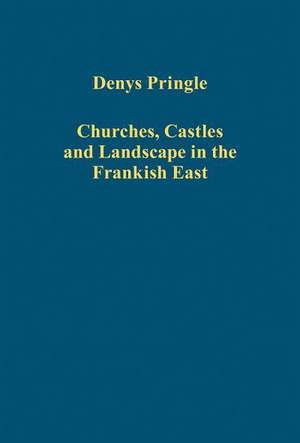Churches, Castles and Landscape in the Frankish East: Variorum Collected Studies
Autor Denys Pringleen Limba Engleză Hardback – 14 ian 2013
Din seria Variorum Collected Studies
-
 Preț: 311.18 lei
Preț: 311.18 lei -
 Preț: 310.55 lei
Preț: 310.55 lei -
 Preț: 299.55 lei
Preț: 299.55 lei - 9%
 Preț: 1041.23 lei
Preț: 1041.23 lei -
 Preț: 386.77 lei
Preț: 386.77 lei -
 Preț: 351.48 lei
Preț: 351.48 lei -
 Preț: 313.38 lei
Preț: 313.38 lei -
 Preț: 386.77 lei
Preț: 386.77 lei -
 Preț: 310.22 lei
Preț: 310.22 lei -
 Preț: 258.66 lei
Preț: 258.66 lei -
 Preț: 343.33 lei
Preț: 343.33 lei - 9%
 Preț: 938.44 lei
Preț: 938.44 lei -
 Preț: 311.41 lei
Preț: 311.41 lei - 9%
 Preț: 938.85 lei
Preț: 938.85 lei -
 Preț: 312.75 lei
Preț: 312.75 lei - 9%
 Preț: 936.60 lei
Preț: 936.60 lei -
 Preț: 341.55 lei
Preț: 341.55 lei -
 Preț: 320.00 lei
Preț: 320.00 lei - 34%
 Preț: 764.20 lei
Preț: 764.20 lei - 22%
 Preț: 312.43 lei
Preț: 312.43 lei - 34%
 Preț: 739.65 lei
Preț: 739.65 lei - 34%
 Preț: 764.20 lei
Preț: 764.20 lei - 34%
 Preț: 680.73 lei
Preț: 680.73 lei - 26%
 Preț: 247.40 lei
Preț: 247.40 lei - 34%
 Preț: 485.78 lei
Preț: 485.78 lei - 34%
 Preț: 764.20 lei
Preț: 764.20 lei - 34%
 Preț: 769.51 lei
Preț: 769.51 lei - 34%
 Preț: 764.20 lei
Preț: 764.20 lei - 34%
 Preț: 826.68 lei
Preț: 826.68 lei - 25%
 Preț: 222.32 lei
Preț: 222.32 lei - 25%
 Preț: 225.54 lei
Preț: 225.54 lei - 34%
 Preț: 767.07 lei
Preț: 767.07 lei - 34%
 Preț: 764.20 lei
Preț: 764.20 lei - 34%
 Preț: 736.38 lei
Preț: 736.38 lei - 34%
 Preț: 738.42 lei
Preț: 738.42 lei - 25%
 Preț: 226.52 lei
Preț: 226.52 lei - 33%
 Preț: 491.66 lei
Preț: 491.66 lei - 34%
 Preț: 485.78 lei
Preț: 485.78 lei - 34%
 Preț: 485.78 lei
Preț: 485.78 lei - 34%
 Preț: 764.20 lei
Preț: 764.20 lei - 34%
 Preț: 736.38 lei
Preț: 736.38 lei - 31%
 Preț: 473.94 lei
Preț: 473.94 lei - 18%
 Preț: 807.71 lei
Preț: 807.71 lei - 34%
 Preț: 764.20 lei
Preț: 764.20 lei - 34%
 Preț: 764.20 lei
Preț: 764.20 lei - 34%
 Preț: 764.20 lei
Preț: 764.20 lei - 51%
 Preț: 485.78 lei
Preț: 485.78 lei - 34%
 Preț: 485.78 lei
Preț: 485.78 lei - 34%
 Preț: 769.10 lei
Preț: 769.10 lei - 34%
 Preț: 766.65 lei
Preț: 766.65 lei
Preț: 800.18 lei
Preț vechi: 1201.77 lei
-33% Nou
Puncte Express: 1200
Preț estimativ în valută:
153.12€ • 157.96$ • 127.78£
153.12€ • 157.96$ • 127.78£
Comandă specială
Livrare economică 05-19 martie
Doresc să fiu notificat când acest titlu va fi disponibil:
Se trimite...
Preluare comenzi: 021 569.72.76
Specificații
ISBN-13: 9781409454977
ISBN-10: 1409454975
Pagini: 368
Ilustrații: Includes 108 b&w illustrations and 61 maps
Dimensiuni: 170 x 245 x 30 mm
Greutate: 0.91 kg
Ediția:New ed.
Editura: Taylor & Francis
Colecția Routledge
Seria Variorum Collected Studies
Locul publicării:Oxford, United Kingdom
ISBN-10: 1409454975
Pagini: 368
Ilustrații: Includes 108 b&w illustrations and 61 maps
Dimensiuni: 170 x 245 x 30 mm
Greutate: 0.91 kg
Ediția:New ed.
Editura: Taylor & Francis
Colecția Routledge
Seria Variorum Collected Studies
Locul publicării:Oxford, United Kingdom
Cuprins
Contents: Preface; Church-building in Palestine before the Crusades; Churches and settlement in Crusader Palestine; The planning of some pilgrimage churches in Crusader Palestine; Cistercian houses in the Kingdom of Jerusalem; The fief of Aimery of Franclieu and the estate of the abbey of St Mary of Mount Sion in the territory of Jerusalem; Perceptions of the castle in the Latin East; A castle in the sand: mottes in the Crusader East; Templar castles between Jaffa and Jerusalem; The castles of Ayla (al-‘Aqaba) in the Crusader, Ayyubid and Mamluk periods; The castle and lordship of Mirabel; Il castello di Belmonte e la proprietà ospedaliera della Terra di Emmaus nel regno crociato di Gerusalemme; Qal’at Jiddin: a castle of the Crusader and Ottoman periods in Galilee (with A. Petersen, M. Dow and C. Singer); Castle chapels in the Frankish East; The church of the Holy Sepulchre in the castle of Tripoli (Mont Pèlerin); The chapels in the Byzantine castle of Sahyun (Qal’at Salah al-Din), Syria; The spring of the Cresson in crusading history; Addenda and corrigenda; Index.
Notă biografică
Denys Pringle is a Professor in the Cardiff School of History, Archaeology and Religion, Cardiff University, UK.
Recenzii
'Le professeur D. Pringle compte certainement parmi les meilleurs connaisseurs de l’histoire, de l’archéologie et de l’architecture médiévales au Proche-Orient ; il est également l’un des auteurs les plus prolixes de la période récente, et les travaux qu’il a publiés depuis le début des années 80 n’ont pas peu contribué au développement de la connaissance de la Terre Sainte.' Bulletin Monumental
Descriere
The studies in this book are the product of the years that Denys Pringle has spent investigating the material evidence for Latin settlement in Syria and Palestine in the twelfth and thirteenth centuries. Focusing on the building remains of churches and castles - and their relationship to the landscape - the volume explores the architecture of the Cistercian houses in Jerusalem, the geographical distribution of church buildings, and the influence that factors such as existing local architectural traditions and the need to accommodate visiting pilgrims may have had on the design of Latin churches and religious houses.
